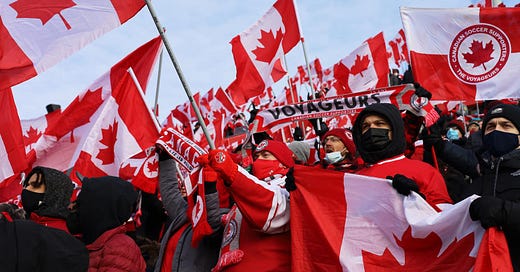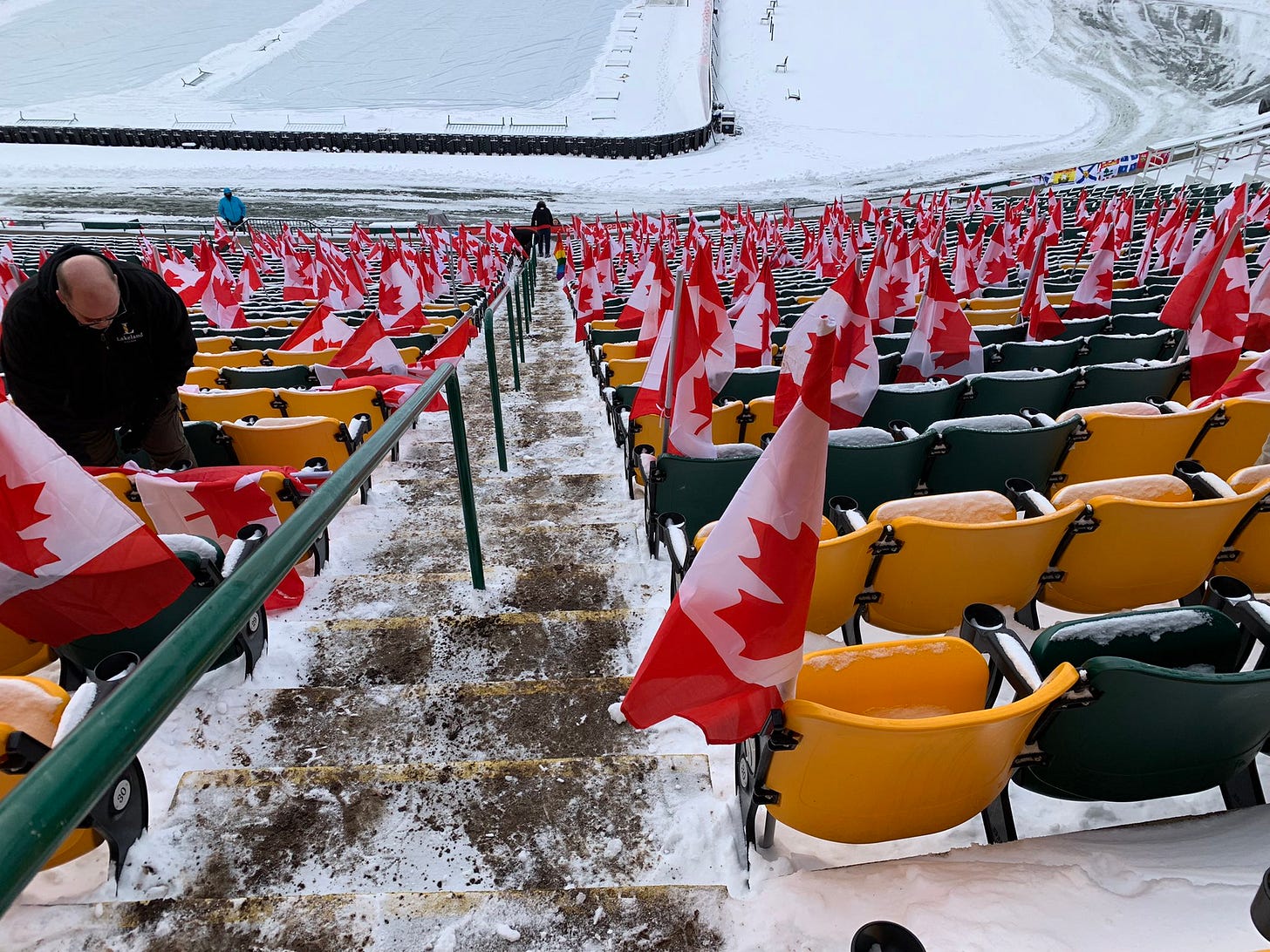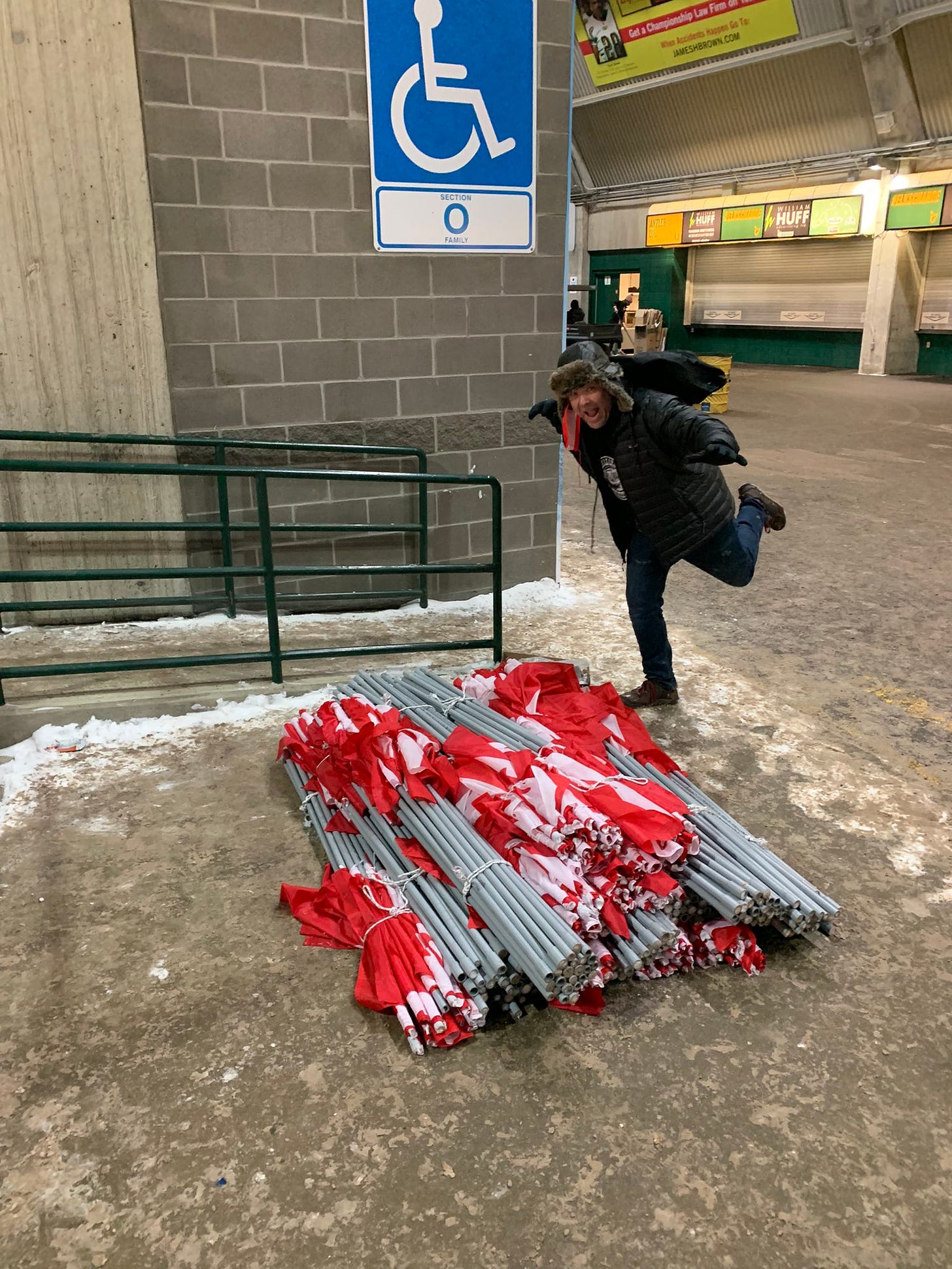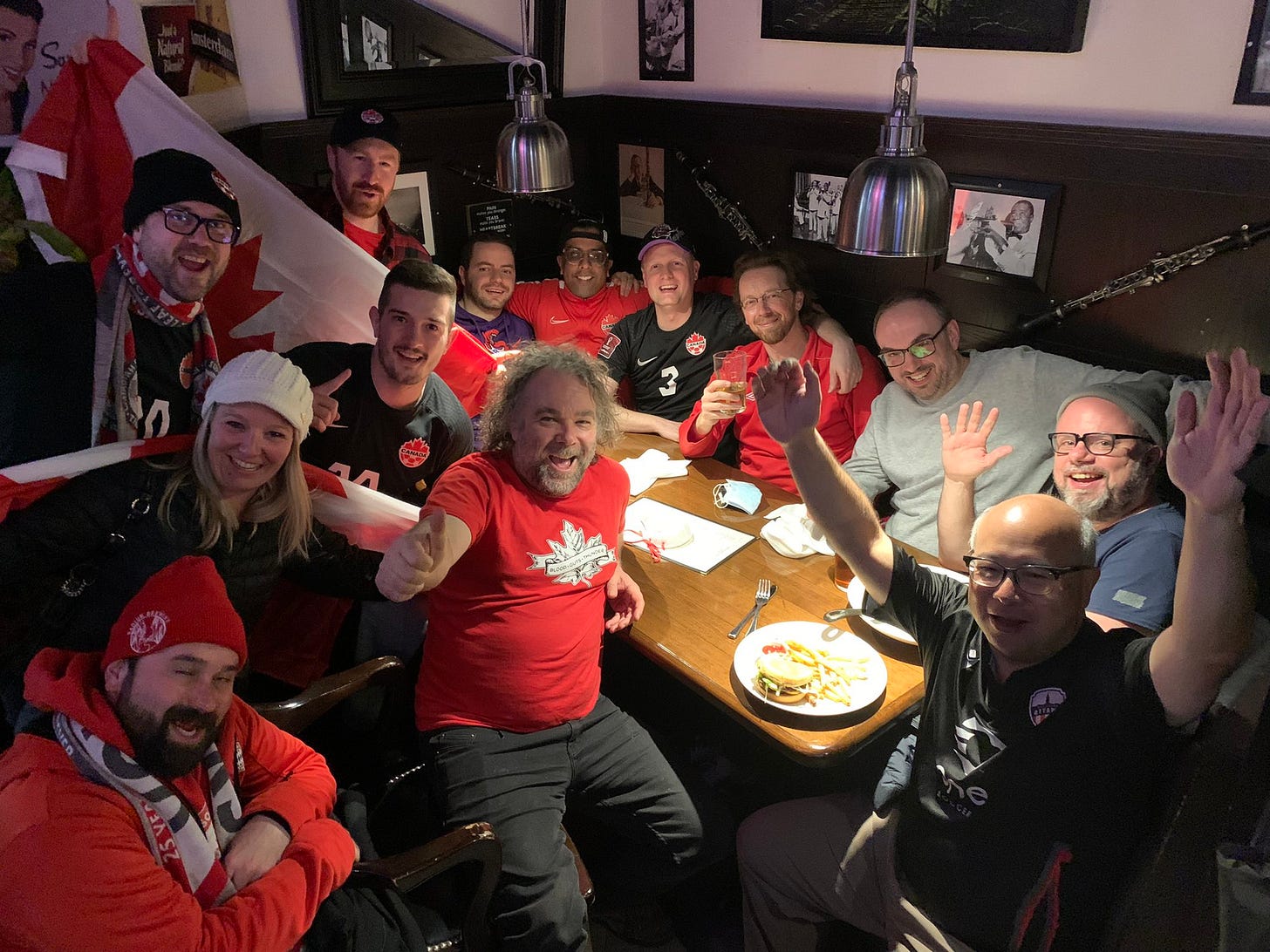Hello, and welcome to American Tifo, a weekly newsletter for, and about, North American soccer supporters. Thank you for being here. If you haven’t already, subscribe! If you’re a member of a supporters group, please consider sharing this with the rest of your SG and encouraging them to subscribe as well.
It is good to be a Canadian soccer supporter right now. Take that in. Let the weight of that statement, which would have seemed laughable, just a few months, let alone a few years ago, settle in. But with a dominant women’s national team that won its first ever Olympic gold medal last summer, and a men’s national team dreaming of World Cup glory, Canada has been the feel-good story of CONCACAF.
At the heart of that story is the Voyageurs, a group of long-suffering, dedicated supporters soaking in the recent success, and helping to guide the rest of the country along for the ride.
“It’s really been such a good 12 months, between the men and the women,” said Aubrey Lustig, a member of the leadership team of the Voyageurs. “It’s just been a pure upward trajectory.”
With the men’s team on the brink of its first World Cup qualification since 1986, enthusiasm for both the men’s national team, and the Voyageurs, has skyrocketed. The group’s leadership team has been dealing with a whirlwind of emotions, including joy, disbelief, shock, exhaustion, weariness, exhaustion excitement, more exhaustion. That’s because the group was never built to handle such an unexpected surge in interest.
“This is beyond anyone’s expectations” Alex Ho, another member of the leadership team. “It comes with challenges. It’s a lot of hard work. I mean, we all have jobs, nobody’s being paid to do this. I’m exhausted at the end of every day. But it’s well worth it.”
The first official appearance of the Voyageurs was in 1996, with two banners displayed at Canada’s match against Panama to kick off its World Cup qualifying campaign. Since then, the Voyageurs have grown steadily, but loosely, with key individuals often driving the momentum of the group. Over the past several years, one supporter, Jamie MacLeod has been the main man for almost everything Canada Soccer.
“Jamie has kind of done this on his own, with the contribution of a few people here and there where he needed them,” said Rob Notenboom, another member of the Voyageur leadership group. “But he has done that on his own for over a decade.”
“He honestly did so much,” said Lustig of MacLeod, who is still actively involved. “He used to buy tickets and send them as PDFs to everyone who bought them. At a certain point, we all realized that we needed to be a little more formal and organized.”
“We recognized heading into 2026, (the 2026 World Cup will be hosted by Canada, the U.S. and Mexico) we needed to get more structure around it and really help work on building all of it,” said Nicky Cottee, another member of the leadership group.
A first step was introducing paid memberships in the spring of 2021. Since it was the first ever paid membership offering, the group decided to offer a t-shirt as part of the new member pack. MacLeod, who owns a heat press for shirts, would be producing these himself.
“I thought we would get to about 800 memberships,” said Cottee. “But it has just exploded beyond that. Now, we’re pushing 3,500 paid memberships.”
“When we hit 2000 members, Jamie said, ‘We’re cutting off the t-shirts,’” said Notenboom.
The group derives its name from the voyageurs of the 18th and 19th century, men responsible for transporting furs along trade routes during the height of the fur trade boom. It’s a uniquely Canadian word, the same in both English and French, a nod to the country’s deep connection to both cultures. Voyageurs journeys were often rigorous, challenging, and thankless, and the comparison to modern day Canadian fandom is apt.
Because to understand what it truly takes to devote oneself to the Canadian national teams, you have to understand a few core principles. First, the national teams do not play frequently at home. From 2010 to 2019, the men’s national team played a total of 24 matches in Canada for an average of 2.4. During that same time the women’s national team played 29 home matches for an average of 2.9. That means that in any given year, you might have 5 shots to see a national team match at home.
Secondly, Canada is huge. Only a few stadiums with the facilities and capacity to host top-level international matches are scattered across the massive country, with Toronto’s BMO Field being a perennial favorite. So the short list of cities that will actually get to host one of those 5.3 matches tightens even more. This means if you want to catch a match in person, you’re going to have to get on a plane, or maybe if you’re lucky, hunker down for a 7 or 8 hour drive. That type of voyage is a sacrifice to see even the most talented of teams. It’s an even bigger ask when your team is bad. Which brings us to our third and final point. Up until recently, the Canada men’s national team was historically bad.
“It was dire stuff,” said Notenboom. “You could watch the women and be somewhat confident of a result, but the men’s team, you never were. It was kind of like getting punched in the face half the time.”
But it’s the scarcity of matches, the intense travel, and the dismal past results that make the men’s team’s current run all the more special.
“It really felt like you shared that passion and desire to help the team, and be a supporter of the team with the other poor suckers involved with it at the time,” said Notenboom. “A lot of us are still here. We’ve all suffered through all of this but we just loved it so much. Now, where we’re at, I don’t really have words for it. It doesn’t feel real most of the time.”
The beginning of this dream run started innocuously enough. Canada kicked off the final leg of its World Cup qualifying campaign at home in September. The last time the men’s team was this close to qualifying for a World Cup was back in 1996 before the 1998 World Cup. But despite the uncharted territory, supporter interest in the first few matches were mild.
“The first couple matches, people didn’t really grasp what was going on,” said Lustig. “Probably within our smaller group of fans, we knew there was a lot of talent. But the first couple games, it was Honduras and El Salvador at home, and tickets didn’t move super quickly for those.”
But then came a draw against Mexico at Estadio Azteca. Six days after that, Alphonso Davies would score a goal that would wake up a nation.
“If there was one single moment where we all just looked at each other and said, ‘That really happened,’ it was the Davies goal. I think that was the turning point,” said Ho.
The mix of speed, flash and emotion caught everyone’s attention.
“I was in the airport the next day and it was being shown on every screen. It was just like, ‘Wow, this never happens,’” said Notenboom.
Mike Friesen, who was relatively new to the Voyageurs had traveled from Winnipeg to Toronto for the match and immediately was swept up in the passion and excitement spreading.
“That was just a world-changing experience for me,” Friesen said. “I’m sitting there in the stands, just feeling the electricity in the stadium. Just kind of feeling, with every song, and the beating drum, that there was actually something to be part of. Representing an entire country in the stands was an incredible feeling.”
“I think about 15 minutes into the game, this one veteran Voyageur looks over at me and says, ‘You’re never gonna miss another game, are you?’ I’m absolutely hooked. Every game is on the calendar,” Friesen said.
All of a sudden, Canada was undefeated after six matches of World Cup qualifying.
“Then we started selling tickets for Edmonton,” Notenboom said, referring to a pair of home matches the men’s national team would play against Costa Rica and Mexico in November.
As the Voyageurs began to do their calculations, factoring in Edmonton’s supporter group population, folks within driving distance who might make the trip, and which diehards would show up, they figured they could sell about 500 tickets, which would leave large amounts of their section empty.
“Canada Soccer was like, ‘We’ll give you these two sections, you sell as much as you can, and then once sales dry up, we’ll take the rest,’” said Notenboom.
The sales never dried up. “Members just kept showing up,” Notenboom said. “We sold 1600 to 2000 for each game.”
As ticket sales climbed ahead of the two matches, the Voyageurs social media DMs and email inbox began to swell with media requests from around the world.
“We just got bombarded by media requests. We got national news, local radio, it just kept going on and on,” said Notenboom.
Hype, interest, enthusiasm, ticket sales, membership sales, media attention. It all just kept getting bigger. Sensing that these two matches could be a watershed moment for the Voyageurs, Notenboom did what any dedicated supporter would do.
“I took 10 days off and basically just relocated to Edmonton,” he said.
“That’s when I really went, ‘This is a national sensation,’” he said. “All of a sudden we were getting media requests of like, ‘Where can we meet you guys to do an interview?’ ‘Who can you get us? Do you have somebody?’ So we started handing it off to people, telling them ‘You gotta do this interview, you gotta do this interview, you gotta do this interview’ Because we couldn’t handle them all ourselves. So, it was pretty bonkers, and it was a lot of fun to do. I started getting messages from people that I hadn’t seen for a decade saying, ‘Did I just see you on TV?’ That for me was the moment, settling in in Edmonton and realizing the whole city had tuned in to this.”
As Notenboom and the rest of the Voyageurs filled the stands and created an electric atmosphere, the players on the field responded in kind, defeating Costa Rica and Mexico, and creating several iconic moments from Cyle Larin’s brace to Sam Adekugbe’s diving snow celebration.

Ahead of Canada’s January home qualifier against the U.S. excitement had reached a fever pitch.
“It’s created a whole bunch of challenges which is a good thing,” said Lustig. “You want the growth to happen. We’ve started to really have to go into the depths of how Ticketmaster works and figure out how to make sure ticketing codes work, making sure that as many people can get tickets as possible.”
Now, there’s one last stop on this magical ride, today in Toronto against Jamaica, where Canada’s World Cup dream could become a reality.
The entire leadership team will be at the match, coming in from all corners of Canada to celebrate the moment.
“What makes me proud is that it’s not just one city, it’s everybody coming in from everywhere to do this,” said Notenboom.
As the men’s national team reaches one summit, with an eye on another in November, the Voyageurs leadership team is also examining what’s next for the group as a whole.
“From an operational standpoint, the real question is where do we go now? What is the long-term goal for the Voyageurs?” said Lustig. “Before, it was just, you sold some tickets, you sold a few scarves. Now, there’s legitimate interest.”
While the group does have some ideas for growth, they won’t truly address anything until they can come up for air from this whirlwind.
“I think everybody is just living here and now and savoring the moment and really just cherishing the idea of finishing at the top of the group,” said Friesen.
“We’re in for the ride, and who knows how long this will last for?” said Ho. “Let’s live for the moment.”








